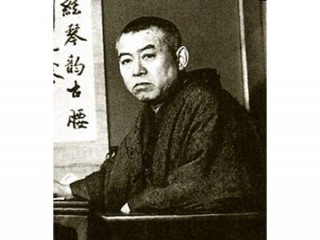
Junichiro Tanizaki biography
Date of birth : 1886-07-24
Date of death : 1965-07-30
Birthplace : Tokyo, Japan
Nationality : Japanese
Category : Famous Figures
Last modified : 2011-08-25
Credited as : Novelist, A Small Kingdom,
Junichiro Tanizaki was a Japanese novelist, essayist, and playwright known for his stylistic virtuosity and depiction of unusual psychological situations.
Junichiro Tanizaki, born in Tokyo, the son of a rice broker, received a conventional education. Entering the Imperial University in 1908, he studied Japanese classical literature but left without taking a degree. From a very young age he was interested in literary pursuits and soon achieved his ambition of devoting his life to art.
Eschewing the flourishing naturalism of the day, Tanizaki sought to create works of beauty through style and mood, inspired in part by the Japanese past and also by certain Western writers such as Edgar Allan Poe, Charles Baudelaire, and Oscar Wilde. Throughout his fiction run strains of eroticism and lyricism together with a good deal of imagery taken from the acute observation of real life. The character of a dominant or destructive woman is much in evidence in many of his novels, as are subtle contrasts of new and old, Japanese and Occidental. Tanizaki saw and depicted vividly the clash between Japan and the West, but on the esthetic plane.
Shisei (1910; The Tatoo), set in the premodern era of the early 19th century, depicts a tattooer and artist who becomes enslaved to a beautiful woman after tattooing a spider on her back while she slept. The richness and beauty of the style brought Tanizaki to the immediate attention of the reading public. Shonen (1912; Children) pursues the vein of "diabolism" with the depiction of children committing unspeakable, and unspecified, horrors. Jotaro (1914) explores the subjects of masochism and madness on the part of a famous author. O-Tsuya Goroshi (1915; The Killing of O-Tsuya), with a picturesque setting of city life in the recent premodern past, is a tale of infidelity, lust, and murder in a vivid, dramatic, and essentially modern technique.
In Itansha no Kanashimi (1917; The Sorrows of a Heretic) the theme of masochism is again set forth. Haha o Kouru-ki (1919; Pining for Mother) depicts mother love and nostalgia for the world of the preceding generation. Chiisana Okoku (1918; A Small Kingdom) has for its theme masochism as well as subjection to inevitable tyranny. It is almost political but not quite. The play Okuni and Gohei (1922) is complex, historical, and violent.
With Chijin no Ai (1925; A Fool's Love) Tanizaki embarked on his first long novel. Set in the foreign quarter of Yokohama, it depicts a man's obsession with a Eurasian prostitute who bears a resemblance to Mary Pickford. It may be an ironic commentary on Japan's dilemma of Westernization. After the great earthquake of 1923 Tanizaki had left Tokyo to establish himself in the more traditional and picturesque Kyoto-Osaka area, where he was to remain. He now turned his attention to depicting the more glamorous aspects of the Japanese past and could look back on modern Tokyo with a certain disdain.
From this time on, Tanizaki's greatest works were written. Tade Kuu Mushi (1929; Some Prefer Nettles) portrays modern life in Kobe and Kyoto, the muted charms of Kyoto versus the blatant cheapness of the modern port city with its shabby cosmopolitanism. Manji (1930; Whirl), a stylistic tour de force written entirely in Osaka dialect, deals with suicide and the perverse. In Yoshino Kudzu (1931), a tone poem that is part essay, part fiction, the hero falls in love with a girl who reminds him of his deceased mother. Momoku Monogatari (1931; A Blind Man's Tale) is a historical tale of the 16th century in which prominent historical personages are "seen" through the eyes of a narrator who is a blind masseur and musician. Stylistically it is one of Tanizaki's greatest achievements, as is Ashikari (1932), a discursive evocation of passion somewhat reminiscent of a No play. Kaoyo (1933), a play set in the 14th century, depends on mood and strangeness for its effect.
Shunkinsho (1934; A Portrait of Shunkin), a most exotic tale, depicts an imperious woman named Shunkin, who is a beautiful blind musician, and her abject body servant. Neko to Shozo to Futari no Onna (1936; A Cat, Shozo, and Two Women) is a perverse and comic novel with a modern setting and humorous tone.
During the 1930s Tanizaki had been working on a modern version of the Tale of Genji, the great classic novel of 10th-century life by Lady Murasaki. This appears to have influenced some of the descriptive passages in his long novel Sasameyuki (1948; The Makioka Sisters), a study of a prominent old Osaka merchant family in decline. It is an important document of contemporary social customs. Returning to the Japanese past with Shosho Shigemoto no Haha (1949; The Mother of Captain Shigemoto), Tanizaki again treated the theme of a youth burdened by the memory of his beautiful mother. Kagi (1956; The Key) and Futen Rojin Nikki (1962; Diary of a Mad Old Man) offer vivid and humorous descriptions of modern depravity in the postwar world.
Elected to the Japanese Academy of Art in 1923 and decorated with the Order of Culture in 1949, Tanizaki occupied a position of eminence in the world of letters for many years. He died in July 1965.
















